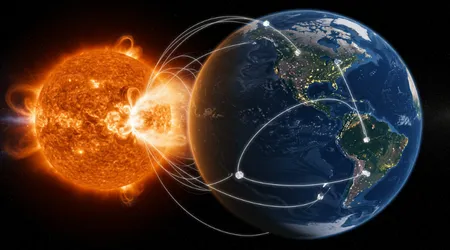Could a Solar Superstorm Take Down the Internet?

The threat of a solar superstorm taking down the internet looms larger than ever in 2025, as our digital world grows increasingly interconnected.
Anúncios
Solar superstorms, massive eruptions of charged particles from the sun, can wreak havoc on Earth’s technological infrastructure.
Recent events, like the May 2024 Gannon Solar Storm, exposed vulnerabilities in GPS systems, with positioning errors reaching up to 230 feet.
As we rely on the internet for everything from commerce to communication, the question isn’t just if a storm could disrupt it, but how catastrophic the fallout would be.
This article dives into the science, risks, and practical steps to mitigate the impact of such a cosmic event, blending cutting-edge research with real-world implications.
Imagine a world where your smartphone goes dark, online banking freezes, and global trade halts. That’s the potential chaos of a solar superstorm taking down the internet.
Unlike a cyberattack, this natural phenomenon doesn’t discriminate it targets the very systems we take for granted.
With solar activity peaking in 2025 during the 26th solar cycle, understanding this threat is urgent. Let’s explore how these storms form, their historical impact, and what we can do to safeguard our digital lifeline.
The Science Behind Solar Superstorms
Solar superstorms stem from the sun’s volatile nature, unleashing solar flares and coronal mass ejections (CMEs). These events hurl billions of tons of plasma toward Earth.
When this plasma hits our magnetic field, it triggers geomagnetic disturbances. The solar superstorm taking down the internet isn’t science fiction it’s a matter of physics.
Charged particles can induce currents in power grids and disrupt satellite communications, which the internet heavily relies on.
Consider the sun as a cosmic engine, occasionally misfiring with devastating consequences. A CME travels millions of miles, reaching Earth in days.
++ What We Still Don’t Understand About Solar Flares
The 1859 Carrington Event, a benchmark superstorm, caused telegraph systems to spark and fail.
Today, our internet infrastructure cables, satellites, and data centers is far more complex and vulnerable. A single CME could overload these systems, creating a cascade of failures.
Recent data from NASA’s Parker Solar Probe, which ventured 3.8 million miles from the sun’s surface in 2024, shows CMEs moving at unprecedented speeds.
These findings underscore the need for real-time monitoring. Without it, a solar superstorm taking down the internet could catch us off guard, disrupting global connectivity in hours.

Historical Impacts and Modern Vulnerabilities
History offers stark warnings about solar superstorms. The Carrington Event fried telegraph lines, but today’s stakes are higher. Our internet-driven society depends on undersea cables and satellites.
A solar superstorm taking down the internet could sever these lifelines, halting everything from streaming services to stock markets. The 1989 Quebec blackout, caused by a milder storm, left millions without power for hours.
Satellites, crucial for internet connectivity, are especially at risk. Geomagnetic storms can damage their electronics, as seen in the 2003 storm that disrupted 47 satellites.
Also read: How Solar Energy Powers the Heliosphere: Unraveling the Sun’s Cosmic Influence
Undersea cables, carrying 95% of global internet traffic, are also vulnerable to induced currents. A solar superstorm taking down the internet could disrupt these cables, causing outages lasting weeks or months.
The May 2024 Gannon Storm, detailed in a Space journal study, cost farmers $500 million due to GPS failures.
This event highlights how even moderate storms expose modern vulnerabilities. Our reliance on interconnected systems amplifies the risk, making preparation critical.
The Internet’s Fragile Backbone
The internet isn’t a single entity it’s a network of cables, servers, and satellites. A solar superstorm taking down the internet targets this backbone.
Submarine cables, stretching thousands of miles, are susceptible to geomagnetic currents. A 2023 study in Space Weather noted that a Carrington-level event could induce voltages strong enough to fry cable amplifiers.
Data centers, housing the cloud, rely on stable power grids. A superstorm could trigger blackouts, shutting down servers. Think of it like a house of cards one push, and the whole structure collapses.
Satellites, meanwhile, face direct hits from charged particles, risking total failure. The solar superstorm taking down the internet could disrupt this delicate balance, leaving us disconnected.
Read more: What Causes the Sun’s Differential Rotation? Unraveling the Star’s Dynamic Spin
Redundancy in internet infrastructure helps, but it’s not foolproof. For example, Starlink’s low-orbit satellites are less vulnerable but not immune.
Strengthening these systems requires investment and foresight something governments and companies are only beginning to prioritize.
Real-Time Monitoring and Prediction Efforts
Can we predict a solar superstorm taking down the internet? NASA’s STEREO-A mission offers hope.
A 2025 Space Weather study showed it could predict CME strength 2 hours and 34 minutes earlier than older systems. Early warnings allow operators to protect power grids and satellites, reducing internet disruption risks.
Space agencies like NOAA monitor solar activity in real time, using tools like the GOES-19 satellite. These systems track solar flares and CMEs, providing data to mitigate impacts.
However, prediction isn’t perfect. A sudden CME could still outpace our defenses, emphasizing the need for robust infrastructure.
Public awareness is also key. If businesses and individuals know a storm is coming, they can back up data or switch to offline systems.
Governments must invest in these early-warning systems to prevent a solar superstorm taking down the internet from becoming a global crisis.
Practical Steps to Mitigate the Risk
Protecting against a solar superstorm taking down the internet starts with preparation. Governments can harden power grids by installing surge protectors and backup systems.
Telecom companies should shield submarine cables and diversify satellite networks. These steps reduce the risk of widespread outages.
On a personal level, individuals can prepare too. Imagine a small business owner, Sarah, who runs an online store. She backs up her website daily and uses a local server for critical data.
When a storm hits, her business stays operational. Simple measures like offline backups can make a difference.
Companies like SpaceX are innovating with resilient satellite networks. Starlink’s design minimizes solar storm damage, but scaling this globally takes time.
Collective action government, industry, and individuals can soften the blow of a solar superstorm taking down the internet.
The Economic and Social Fallout

A solar superstorm taking down the internet would ripple through economies. Global trade, reliant on digital transactions, could grind to a halt.
In 2024, global e-commerce generated $6.3 trillion. Weeks of internet outages could cost billions daily, dwarfing the Gannon Storm’s $500 million agricultural hit.
Socially, the impact would be profound. Imagine hospitals unable to access patient records or emergency services cut off from communication.
Online education and remote work would collapse, isolating communities. The solar superstorm taking down the internet could fracture our social fabric, exposing our digital dependency.
Consider a rural farmer, John, who relies on GPS for planting. A storm disrupts his equipment, delaying crops and spiking food prices. These cascading effects show why preparation isn’t optional it’s essential.
The Role of Policy and Global Cooperation
Mitigating a solar superstorm taking down the internet requires global cooperation. Nations must share data from solar observatories to improve predictions.
Policies should mandate infrastructure resilience, like the EU’s 2024 grid-hardening initiative. Without coordination, vulnerabilities persist.
International bodies like the UN could lead efforts, standardizing protocols for storm response. For example, Japan’s investment in shielded power lines reduced outage risks during the 2023 storm.
Such models can guide global strategies, minimizing the threat of a solar superstorm taking down the internet.
Public-private partnerships are equally vital. Telecom giants and governments must collaborate to fund resilient systems.
The cost is high, but the alternative global disconnection is far worse. Why wait for a crisis to act?
Table: Impacts of Solar Superstorms on Technology
| Event | Year | Impact | Estimated Cost |
|---|---|---|---|
| Carrington Event | 1859 | Telegraph system failures | Unknown |
| Quebec Blackout | 1989 | Power outage for 6 million people | $2 billion |
| Gannon Solar Storm | 2024 | GPS errors, agricultural losses | $500 million |
Conclusion
The specter of a solar superstorm taking down the internet isn’t a distant threat it’s a real risk in 2025’s hyper-connected world.
From the Carrington Event to the Gannon Storm’s $500 million toll, history shows the destructive power of solar outbursts.
Our internet, a fragile web of cables and satellites, faces unprecedented challenges. Yet, with real-time monitoring, resilient infrastructure, and global cooperation, we can mitigate the worst outcomes.
Think of the internet as a digital heartbeat vital, yet vulnerable. By acting now hardening grids, diversifying networks, and raising awareness we can keep it beating.
The question is, will we prepare before the next storm strikes? The answer lies in our collective resolve to face this cosmic challenge head-on.
Frequently Asked Questions
Q: How likely is a solar superstorm in 2025?
A: The 26th solar cycle peaks in 2025, increasing the chance of a major storm, though Carrington-level events are rare, occurring roughly once every 150 years.
Q: Can individuals protect their devices from a solar superstorm?
A: Yes, using surge protectors and offline backups can safeguard critical data. Businesses should diversify servers to reduce reliance on single systems.
Q: How long could an internet outage last?
A: Depending on the storm’s severity, outages could last days to months, especially if submarine cables or satellites are damaged.
Q: Are governments prepared for a solar superstorm?
A: Some, like Japan and the EU, have invested in resilient grids, but global preparedness varies, with many nations lagging in infrastructure upgrades.
